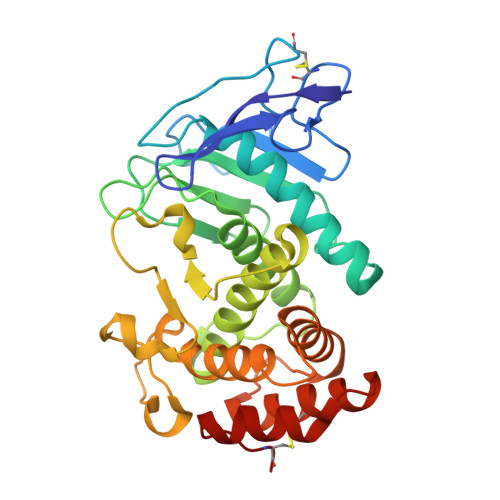Tackling Pseudomonas aeruginosa Virulence by a Hydroxamic Acid-Based LasB Inhibitor.
Kany, A.M., Sikandar, A., Yahiaoui, S., Haupenthal, J., Walter, I., Empting, M., Kohnke, J., Hartmann, R.W.(2018) ACS Chem Biol 13: 2449-2455
- PubMed: 30088919
- DOI: https://doi.org/10.1021/acschembio.8b00257
- Primary Citation of Related Structures:
6FZX - PubMed Abstract:
In search of novel antibiotics to combat the challenging spread of resistant pathogens, bacterial proteases represent promising targets for pathoblocker development. A common motif for protease inhibitors is the hydroxamic acid function, yet this group has often been related to unspecific inhibition of various metalloproteases. In this work, the inhibition of LasB, a harmful zinc metalloprotease secreted by Pseudomonas aeruginosa, through a hydroxamate derivative is described. The present inhibitor was developed based on a recently reported, highly selective thiol scaffold. Using X-ray crystallography, the lack of inhibition of a range of human matrix metalloproteases could be attributed to a distinct binding mode sparing the S1' pocket. The inhibitor was shown to restore the effect of the antimicrobial peptide LL-37, decrease the formation of P. aeruginosa biofilm and, for the first time for a LasB inhibitor, reduce the release of extracellular DNA. Hence, it is capable of disrupting several important bacterial resistance mechanisms. These results highlight the potential of protease inhibitors to fight bacterial infections and point out the possibility to achieve selective inhibition even with a strong zinc anchor.
- Department of Drug Design and Optimization , Helmholtz Institute for Pharmaceutical Research Saarland (HIPS) , Campus E8.1 , 66123 Saarbrücken , Germany.
Organizational Affiliation:





















